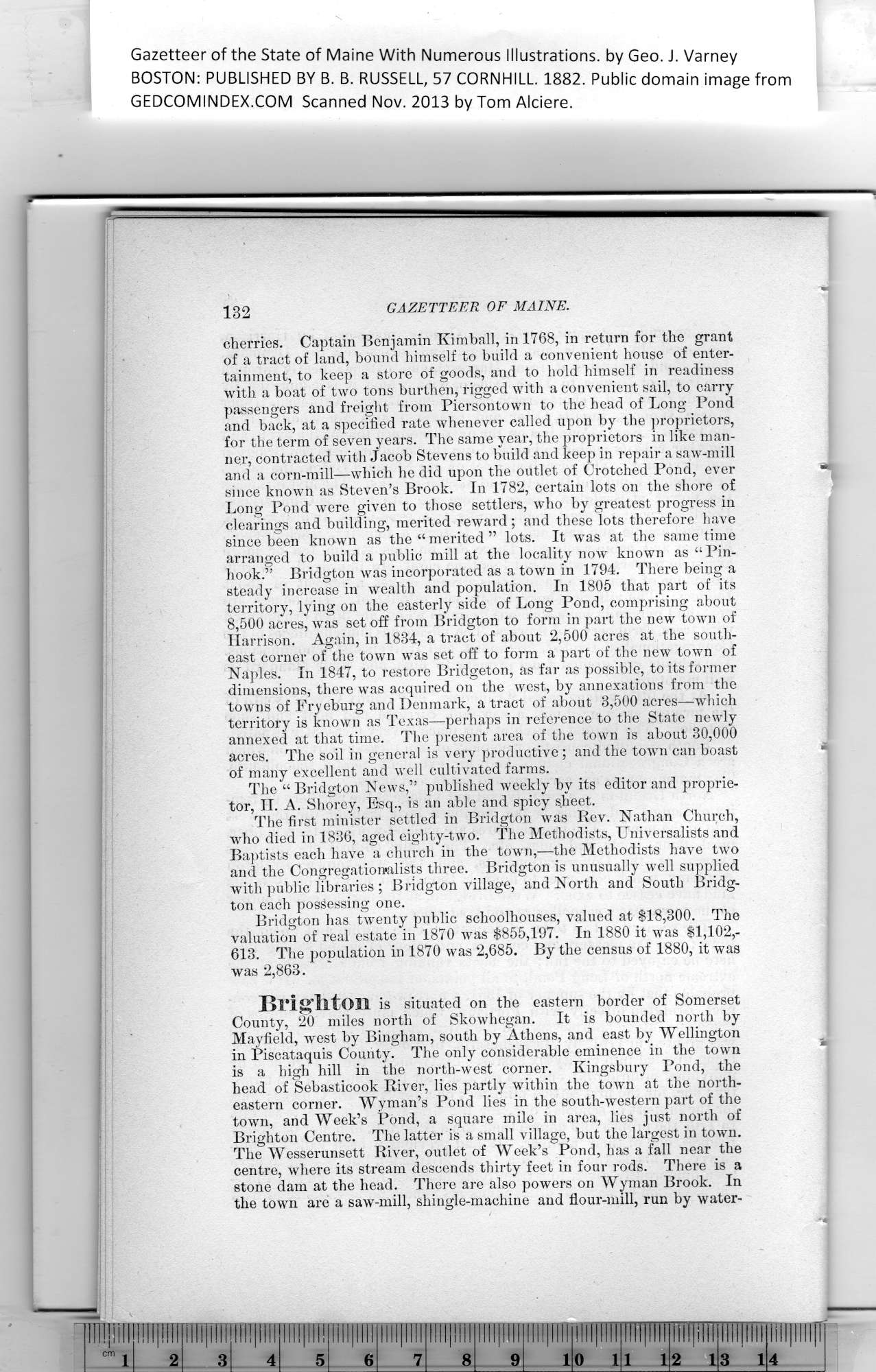|
Gazetteer of the State of Maine With Numerous Illustrations, by Geo. J. Varney
BOSTON: PUBLISHED BY B. B. RUSSELL, 57 CORNHILL. 1882. Public domain image from
132 GAZETTEER OF MAINE.
cherries. Captain Benjamin Kimball, in 1768, in return for the grant
of a tract of land, bound himself to build a convenient house of enter-
tainment, to keep a store of goods, and to hold himself in readiness
with a boat of two tons burthen, rigged with a convenient sail, to carry
passengers and freight from Piersontown to the head of Long Pond
and back, at a specified rate whenever called upon by the proprietors,
for the term of seven years. The same year, the proprietors in like man-
ner, contracted with Jacob Stevens to build and keep in repair a saw-mill
and a corn-mill—which he did upon the outlet of Crotched Pond, ever
since known as Steven’s Brook. In 1782, certain lots on the shore of
Long Pond were given to those settlers, who by greatest progress in
clearings and building, merited reward; and these lots therefore have
since been known as the “merited” lots. It was at the same time
arranged to build a public mill at the locality now known as “ Pin-
hook.” Bridgton was incorporated as a town in 1794. There being a
steady increase in wealth and population. In 1805 that part of its
territory, lying on the easterly side of Long Pond, comprising about
8,500 acres, was set off from Bridgton to form in part the new town of
Harrison. Again, in 1834, a tract of about 2,500 acres at the south-
east corner of the town was set off to form a part of the new town of
Naples. In 1847, to restore Bridgeton, as far as possible, to its former
dimensions, there was acquired on the west, by annexations from the
towns of Fryeburg and Denmark, a tract of about 3,500 acres—which
territory is known as Texas—perhaps in refej'ence to the State newly
annexed at that time. The present area of the town is about 30,000
acres. The soil in general is very productive ; and the town can boast
of many excellent and well cultivated farms.
The “ Bridgton News,” published weekly by its editor and proprie-
tor, H. A. Shorey, Esq., is an able and spicy sheet.
The first minister settled in Bridgton was Rev. Nathan Church,
who died in 1836, aged eighty-two. The Methodists, Universalists and
Baptists each have a church in the town,—the Methodists have two
and the Congregatiorealists three. Bridgton is unusually well supplied
with public libraries ; Bridgton village, and North and South Bridg-
ton each possessing one.
Bridgton has twenty public schoolhouses, valued at $18,300. The
valuation of real estate in 1870 was $855,197. In 1880 it was $1,102,-
613. The population in 1870 was 2,685. By the census of 1880, it was
was 2,863.
Brighton is situated on the eastern border of Somerset
County, 20 miles north of Skowhegan. It is bounded north by
Mayfield, west by Bingham, south by Athens, and east by Wellington
in Piscataquis County. The only considerable eminence in the town
is a high hill in the north-west corner. Kingsbury Pond, the
head of Sebastieook River, lies partly within the town at the north-
eastern corner. Wyman’s Pond lies in the south-western part of the
town, and Week’s Pond, a square mile in area, lies just north of
Brighton Centre. The latter is a small village, but the largest in town.
The Wesserunsett River, outlet of Week’s Pond, has a fall near the
centre, where its stream descends thirty feet in four rods. There is a
stone dam at the head. There are also powers on Wyman Brook. In
the town are a saw-mill, shingle-machine and flour-mill, run by water-
PREVIOUS PAGE ... NEXT PAGE
This page was written in HTML using a program written in Python 3.2
|
